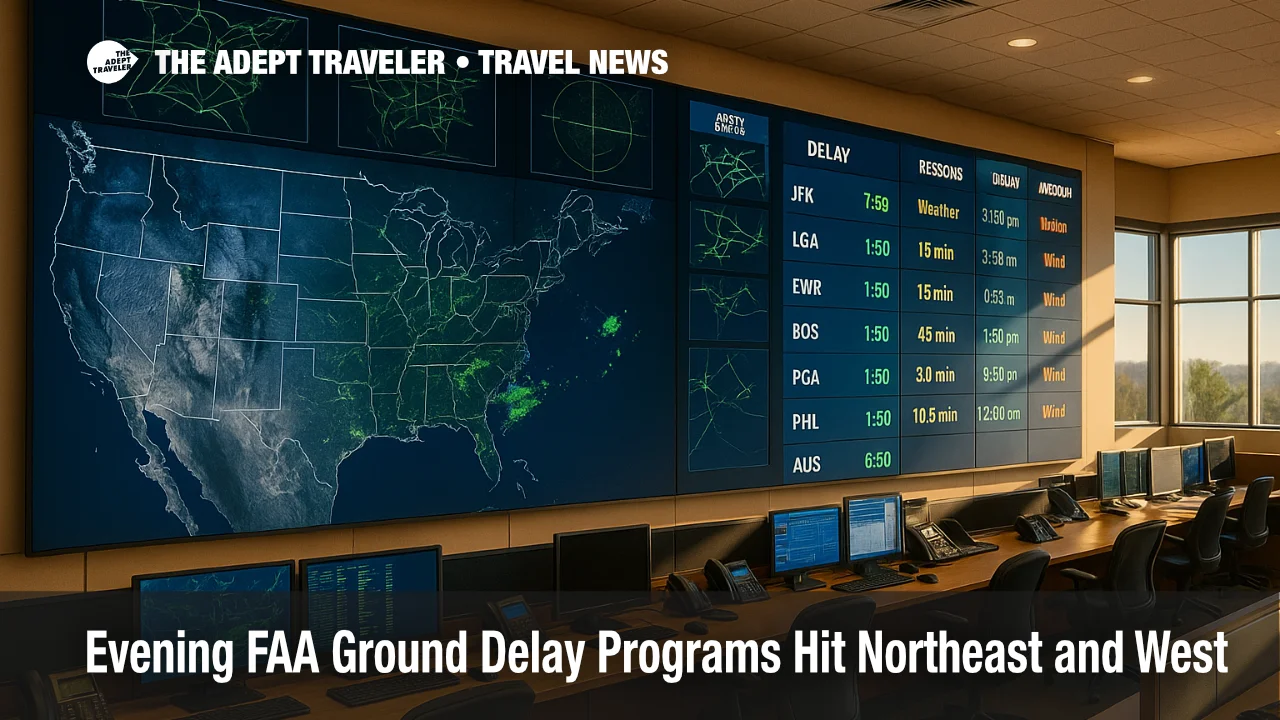Evening FAA ground delay programs hit Northeast and West

Multiple FAA ground delay programs remain in effect this evening as a departing nor'easter and lingering winds constrain arrivals in the Northeast, and added flow programs slow select Western hubs. Travelers should expect rolling EDCT changes, compression opportunities, and some misconnect risk on late banks. Use airline apps to monitor EDCT shifts and consider longer legal connections where possible. See the daytime overview here for broader context, Flight delays and airport impacts: October 13, 2025.
Key points
- Why it matters: FAA ground delay programs continue this evening, raising misconnect risk.
- Travel impact: Late arrivals at New York, Boston, and Washington could ripple into morning banks.
- What's next: Programs taper overnight as winds ease; expect compression windows.
- EDCT tips can pull you earlier, but re-sequencing can also push you later.
- Rebooking works best before departure when a misconnect is likely.
Snapshot
As of late evening on October 13, the FAA lists active or tapering ground delay programs for John F. Kennedy International Airport (JFK) until 1159 p.m. CDT, LaGuardia Airport (LGA) until 159 a.m. CDT, Newark Liberty International Airport (EWR) until 959 p.m. CDT, Boston Logan International Airport (BOS) until 159 a.m. CDT, and Ronald Reagan Washington National Airport (DCA) until 1059 p.m. CDT. Philadelphia International Airport (PHL) saw a brief ground stop and a short GDP that is tapering this evening. In the West, Phoenix Sky Harbor International Airport (PHX) has an evening GDP until 759 p.m. CDT, Austin Bergstrom International Airport (AUS) until 859 p.m. CDT, and San Francisco International Airport (SFO) until 1259 a.m. CDT. End times can shift with updated acceptance rates and compression.
Background
Ground delay programs, or GDPs, meter arrivals into constrained airports by assigning each flight an Estimated Departure Clearance Time, or EDCT. Programs are triggered by reduced arrival rates from weather, runway configuration, traffic-management initiatives, or staffing constraints. A departing coastal low is driving gusty crosswinds and periodic low ceilings across the Northeast this evening, while isolated weather and volume initiatives add delays in Phoenix, Austin, and San Francisco. During GDPs, airline systems continuously recalculate EDCTs. Compression, when cancellations or early departures free up slots, can pull flights forward. Re-sequencing, when flows tighten or acceptance drops, can push flights later. Monitoring your EDCT, staying close to the gate, and asking about alternates are the best levers travelers control.
Latest developments
Airport-by-airport evening status and EDCT tips
JFK until 1159 p.m. CDT. LGA until 159 a.m. CDT. EWR until 959 p.m. CDT. BOS until 159 a.m. CDT. DCA until 1059 p.m. CDT. PHL tapered after a short ground stop. PHX until 759 p.m. CDT. AUS until 859 p.m. CDT. SFO until 1259 a.m. CDT. Track EDCTs in your airline app and on the airport monitors. If your EDCT slips by more than an hour, ask the gate agent about revalidation, alternate routings that bypass the tightest arrival banks, or protection on a later connection. Stay near the gate after boarding, since compression can move pushback earlier with little notice. If your domestic connection in New York or Boston is under 45 minutes tonight, request protection on the next flight before departure.
Rebooking guidance during FAA ground delay programs
Same-day changes are commonly allowed when a meaningful delay is posted under a GDP. Agents can often move you to flights outside peak arrival banks at New York and Boston to reduce risk. If a misconnect is likely, get protected on a later flight before you leave the origin, and clarify hotel and meal rules if the new arrival falls after local curfew. Basic economy tickets are more restricted, but a "customer service reissue due to ATC GDP" can help. For international trips, prioritize making the long-haul sector and rebook the short domestic leg for the next day. Check your travel-insurance benefits, which typically start after 3 to 6 hours, and keep receipts for meals, ground transport, and lodging.
Analysis
Tonight's pattern reflects classic post-nor'easter metering, with winds and periodic ceiling issues reducing arrival acceptance rates at New York, Boston, and Washington. The FAA is using GDPs to smooth inbound demand into the late evening banks while airlines run recovery operations. Expect the most pronounced connection risk at LaGuardia and Boston where short-haul banks are dense and gate turnover is tight. Newark's earlier taper should ease pressure on late arrivals, though gate holds are possible during surges. In the West, Phoenix and Austin programs are primarily flow-control and weather driven; delays are meaningful but less prone to multi-hour pushes. San Francisco's longer runway-configuration and flow-mix constraints make late-night EDCT drift more likely. For travelers, the best move is to pre-authorize backup options before boarding, monitor EDCT changes every 10 to 15 minutes, and ask about alternates that arrive outside the tightest acceptance windows. These steps align with how FAA ground delay programs reallocate scarce arrival slots.
Final thoughts
With FAA ground delay programs continuing into the late evening, success hinges on watching EDCTs, staying flexible on connections, and requesting protection before you depart. As winds ease overnight, compression should open pockets of improvement, but some late misconnects will carry into morning recovery banks. Keep receipts for any trip-delay claims and confirm your airline's overnight policies at the gate. The playbook remains the same, but execution matters when FAA ground delay programs are in force.
